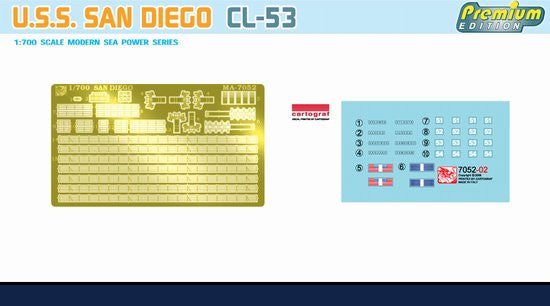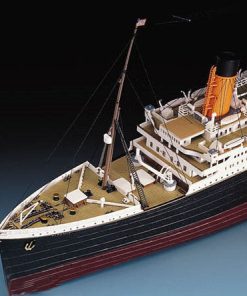Dragon Model Ships 1/700 USS San Diego CL53 Atlanta Class Cruiser Premium Edition Kit This Product Usually Ships In 2-3 Business Days
$ 39,95 $ 23,97
After shakedown training in Chesapeake Bay, San Diego sailed via the Panama Canal to the west coast, arriving at her namesake city on 16 May 1942. Escorting Saratoga (CV-3) at best speed, San Diego barely missed the Battle of Midway. On 15 June, she began escort duty for Hornet (CV-8) in operations in the South Pacific. Early in August, she supported the first American offensive of the war, the invasion of the Solomons at Guadalcanal. With powerful air and naval forces, the Japanese fiercely contested the American thrust and inflicted heavy damage; San Diego witnessed the sinking of Wasp (CV-7) on 15 September and of Hornet on 26 October.
San Diego gave antiaircraft protection for Enterprise (CV-6) as part of the decisive three-day Naval Battle of Guadalcanal, 12 to 15 November 1942. After several months of service in the dangerous waters surrounding the Solomon Islands, San Diego sailed via Espiritu Santo, New Hebrides, to Auckland New Zealand, for replenishment.
She was decommissioned and placed in the Pacific Reserve Fleet on 4 November 1946, berthed at Bremerton, Washington. She was redesignated CLAA-53 on 18 March 1949. Ten years later, she was struck from the Naval Vessel Register, on 1 March 1959.
San Diego received 15 battle stars for service in World War II.
- New arrangement of bridge structure
- Updated radar for USS San Diego
- Improved 120mm cannons
- Updated 20mm single mount guns
- Updated 40mm Bofors quad mount cannons
- New 1.1″ machine cannons by photo-etched part
- Photo-etched racks for depth charges
- Deck railings rendered by photo-etched parts
- New life rafts (2 types)
- New Cartograf decals
Professionally packed and fast shipping
Because of our long-standing partnership with UPS, FedEx, DHL and many other top global carriers we can provide an array of shipping options. Our warehouse staff are highly skilled and will pack your products according to our exact and precise specifications. Your products will go through an extensive inspection and will be properly secured before they are shipped. We ship to thousands clients every day in a variety of countries. Our determination to be the biggest online retailer around the globe is evident by this. Warehouses and distribution centers are located throughout Europe and the USA.
Orders with more than one item are given processing time in accordance with the item.
Before shipping, we will examine the items ordered thoroughly before sending the items. Today, the majority of orders will be delivered within 48 hours. The expected delivery time will be between 3 and 7 days.
Returns
Due to the multiple parties involved which include the factory as well as the warehouse, we are unable to completely manage our stock. So the actual stock may change at any time. Be aware that it's possible for your order to become unavailable even after you have placed the order.
Our policy is valid for 30 days. However, if thirty days have passed after you bought your product, we are unable to provide a refund or exchange.
Your item should be in the original packaging and in good condition. It must also not be used. It should also be in the original packaging.
Related products
MODEL SHIPS
Airfix Ship Models 1/144 Wasa Sailing Ship (Re-Issue) Kit Estimated Shipping: 2-3 Business Days
MODEL SHIPS
AFV Club Ships 1/700 ROCN Chi Yang Knox-Class Frigate Kit Estimated Shipping: 2-3 Business Days
MODEL SHIPS
Academy Ships 1/400 USS Missouri BB63 Battleship Kit Estimated Shipping: 2-3 Business Days
MODEL SHIPS
Academy Ships 1/800 USS Nimitz CVN68 Aircraft Carrier Kit Estimated Shipping: 2-3 Business Days
MODEL SHIPS
Academy Ships 1/1000 RMS Titanic Ocean Liner (Snap) Kit Estimated Shipping: 2-3 Business Days
MODEL SHIPS
AFV Club Ships 1/350 IJN I58 Submarine Kit This Product Usually Ships In 2-3 Business Days





















































